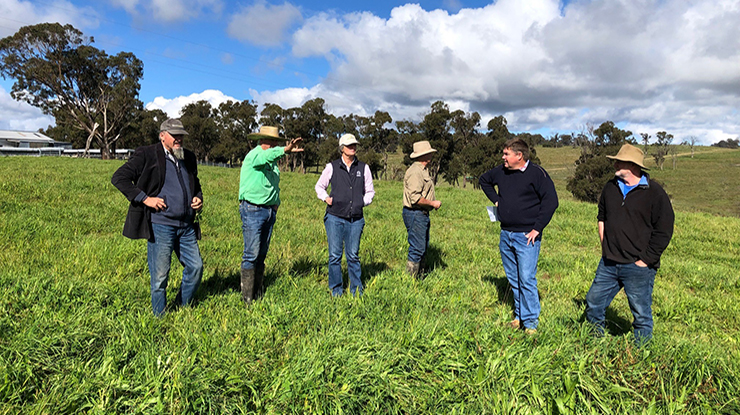 Pasture paddock walk at Te-Angie. Image by Lu Hogan
Pasture paddock walk at Te-Angie. Image by Lu Hogan
Key points:
- Different methodology and pasture types were planted during a recent Producer Demonstration Site (PDS) project to identify the most productive pasture improvement phase with the greatest return on investment (ROI). The 'improved permanent pasture' was the most successful out of the three phases.
- Increased carrying capacity with permanent pasture application had an identified increase of up to 317% over a five-year lifespan.
- Stock on improved pastures returned, on average, 100kg heavier weight than those not on the test site.
Based near Ebor on the Northern Tablelands of NSW, with a combined total of 4,050-ha, Richard and Kerryn Ogilvie run two mixed enterprise farms, 'Te-Angie' and 'Forest Lodge'.
Originally from South Australia, the Ogilvies run a Hereford stud as well as commercial Herefords, a composite prime lamb flock and trade cattle and lambs on their properties with their son Michael and his partner Claire.
Three phases of pasture improvement
By taking part in an MLA-funded Producer Demonstration Site (PDS) project, 'Restoring pasture productivity in the northern tablelands', managed by the Northern Pastures Group, Richard said he believed he could substantially improve the productivity of his property 'Te-Angie'. The demonstration site at Te-Angie, focused on a program of pasture improvement and fertiliser application.
"As part of the program, we monitored the productivity and returns from a 120ha paddock through three phases of pasture improvement," Richard said.
The phases were:
- Phase 1 – The paddock was sprayed with RoundUp, Cutless and insecticide in October 2020 and sown with millet in November 2020. The millet was grazed by trade cattle until autumn 2021.
- Phase 2 – The paddock was sprayed out in autumn 2021 and sown with Bennett's wheat. The wheat was grazed by cows and calves, ewes and lambs and trade cattle until spring 2021.
- Phase 3 – The paddock was sprayed out again in spring 2021 and fallowed until January 2022 when it was sown with a mix of Tower Fescue, Prairie Grass, Holdfast Phalaris, Howlong Cocksfoot, chicory, plantain and red clover at a rate of 16kg/ha. This sowing was brought forward as a consequence of the wet conditions in the summer of 2021–22 and concerns about trafficability in the autumn. From March 2022, the paddock was stocked with heifers.
Return on investment: improved pastures coming out on top
Based on actual weight gains of trade cattle and agistment rates applied for grazing by breeding cows and ewes, the three pasture improvement phases had varying rates of return.
Phase 1 (millet phase):
- The millet phase of grazing produced 23,683kg of live weight gain at an average cost of $1.88/kg of live weight gain.
- The weight gain was valued between $4.20–$5.20/kg live weight at the point of sale.
- The gross margin was $390/ha and the return on investment in the millet phase was 126%.
Phase 2 (wheat phase):
- The wheat phase had a negative return, attributed in part to the wet conditions and unsubstantial crop growth (although this did allow for additional weed control).
- Agistment rates were applied to cows and calves and ewes and lambs grazing the paddock.
- Actual live weight gain for trade cattle was valued at $5/kg.
- The wheat phase made a loss of $21/ha.
- Future plans include the use of triticale rather than winter wheat to handle the cold and wet conditions better.
Phase 3 (permanent pasture):
- The permanent pasture was sown in January 2022 and has been grazed since March 2022.
- The stocking rate of the paddock is conservatively estimated to have increased from 5 dse/ha to 14 dse/ha on a year-round basis.
- Using an average gross margin value of $62/dse, the value of the additional 9 dse/ha carrying capacity is $558/ha/year after allowing for maintenance applications of fertiliser.
- The returns in the first year pay for the pasture improvement costs. The return on investment increases the longer the period until the pasture is required to be renovated (see Table 1).
- Even with a five-year lifespan, the return on investment is $317%.
Table 1: Summary of pasture improvement phases - gross margin and return on investment
Summary* |
Gross margin/ha/year |
Return on investment |
Millet phase |
$390 |
126% |
Wheat phase |
-$21 |
-7% |
Permanent pasture – 5 years |
$558 |
317% |
Permanent pasture – 10 years |
$558 |
436% |
Permanent pasture – 15 years |
$558 |
499% |
* No allowance has been made for changes in livestock inventory value during the period of grazing.
Looking forward
The Northern Pastures Group will continue to monitor the performance of the Ogilvies' paddock on Te-Angie to confirm the estimated improvement in carrying capacity and returns.
Richard said there have been additional benefits from pasture improvement.
"Calf weaning weights from improved pastures are up to 100kg higher than calves from unimproved paddocks. Similarly, cows weaning calves off improved pastures are significantly heavier. The pasture improvement program at Te-Angie is also contributing to the capital value of the farms."






